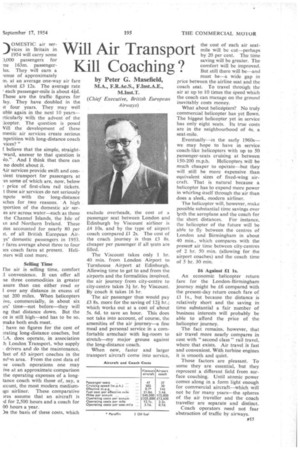Will Air Transp Kill Coaching
Page 105

If you've noticed an error in this article please click here to report it so we can fix it.
by Peter G. Masefield, M.A., F.R.Ae.S., F.Inst.A.E., Minst.T. (Chief Executive, British European Airways) )0MESTIC air services in Britain in 1954 will carry some 3,000 passengers for ne 163m. passengerles. They will earn a 7enue of approximately in. at an average one-way air fare about £.3 12s. The average rate
• each passenger-mile is about 4id. Mose are the traffic figures for lay. They have doubled in the st four years. They may well uble again in the next 10 yearsrticularly with the advent of the 'icopter. The question is posed Viii the development of these mestic air services create serious ripetition with long-distance coach vices? "
believe that the simple, straight-ward, answer to that question is
■ To.".. And I think that there can no doubt about it.
kit services provide swift and con-tient transport for passengers at .es some of which are, now, below
price of first-class rail tickets. t these air services do not seriously /vete with the long-distance iches for two reasons. • A high )portion of the domestic air seres are across water—such as those
the Channel Islands, the Isle of in and Northern Ireland. These ftes accounted for nearly 80 per it. of all British European Airys' domestic passengers in 1953. r fares average about three to four les coach fares at present. Heli3ters will cost more.
Selling Time ['he air is selling time, comfort convenience. It can offer all se three commodities in greater asure than can either road or 1 over any distance , in excess of 3ut 200 miles. When helicopters ive, commercially, in about six Lrs' time—not before—they will ng that distance down. But the ce is still high—and has to be so, make both ends meet.
: have no figures for the cost of rating long-distance coaches, but does operate, in association :h London Transport, who supply drivers and do the maintenance, leet of .65 airport coaches in the ndnn area. From the cost data of se coach operations one may lye at an approximate comparison the operating expenses of a longtance coach with those of, say, a ;count, the most modern mediumige airliner. These comparative ires assume that an aircraft is for 2,500 hours and a coach for 00 hours a year.
)n the basis of these costs, which exclude overheads, the cost ot passenger seat between London and Edinburgh by Viscount airliner is £4 10s. and by the type of airport coach compared ft 2s. The cost of the coach journey is thus £3 8s. cheaper per passenger if all vats are filled.
The Viscount takes only 1 hr. 40 min. from London Airport to Turnhouse Airport at Edinburgh. Allowing time to get to and from the airports and the formalities involved, the air journey from city-centre to city-centre takes 3f hr. by Viscount. By coach it takes 16 hr.
The air passenger thus would pay £3 8s. more for the saving of ln hr.; which works out at a cost of about 5s. 6d. to save an hour. This does not take into account, of course, the amenities of the air journey—a fine meal and personal service in a comfortable armchair with leg-room to stretch—my major grouse against the long-distance coach.
When new, faster and larger transport aircraft come into service, mile will be cut—perhaps by 20 per cent. The time saving will be greater. The comfort will be improved. But still there will be—and must be—a wide gap in price between the airline seat and the coach seat. To travel throUgh the air at up to 10 times the speed which the coach can manage on the ground inevitably costs money.
What about helicopters? No truly commercial helicopter has yet flown. The biggest helicopter yet in service has only eight seats. Its true costs are in the neighbourhood of 4s. a seat-mile.
Eventually—in the early 1960s— we may hope to have in service coach-like helicopters with up to 50 passenger-seats cruising at between 150-200 mph. Helicopters will be much cheaper to operate—but they will still be more expensive than equivalent sizes of fixed-wing aircraft. That is natural because a helicopter has to expend more power in whirling itself through the air than does a sleek, modern airliner.
The helicopter will, however, make possible substantial time savings over loth the aeroplane and the coach for the short distances. For instance, the helicopter of the future will be able to fly between the centres of London and Birmingham in about 40 min., which compares with the present air time between city-centres of 2 hr. 50 min. (allowing for the airport coaches) and the coach time of 5 hr. 30 min.
16 Against Ll is.
An economic helicopter return fare for the London-Birmingham journey might be £6 compared with the present-day return coach fare of £1 is., but because the distance is relatively short and the saving in time substantial a fair number of business interests will probably be able to afford the price of the helicopter journey.
The fact remains, however, that air travel more nearly compares in cost with "second class" rail travel, where that exists. Air travel is fast and convenient. With turbine engines it is smooth and quiet.
Those factors are pleasant. To some they are essential, but they represent a different field from sur face coaching. Until atomic power comes along in a form light enough for commercial aircraft—which will not be for many years—the spheres of the air traveller and the coach traveller are separate and distinct.
Coach operators need not fear abstraction of traffic by airways.












































































































































































































